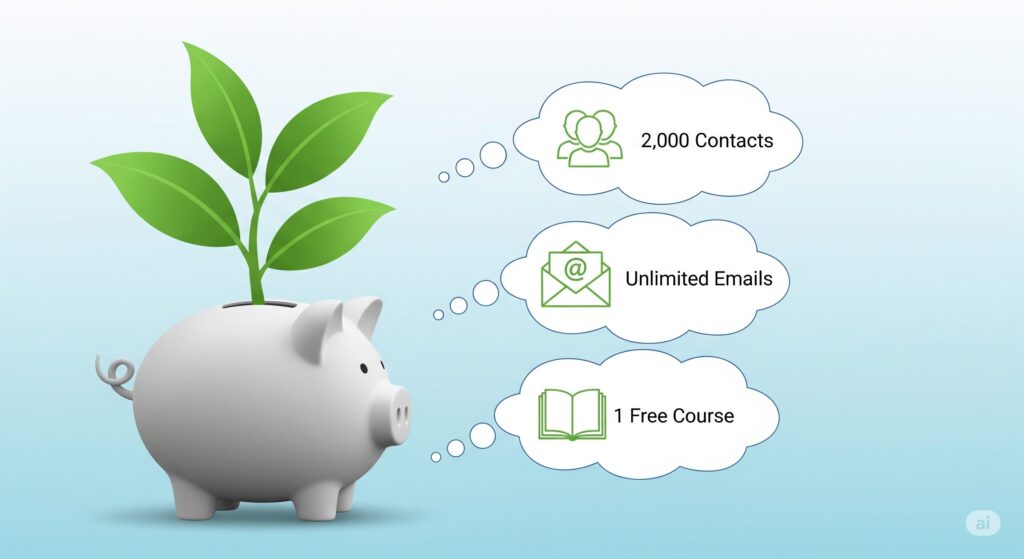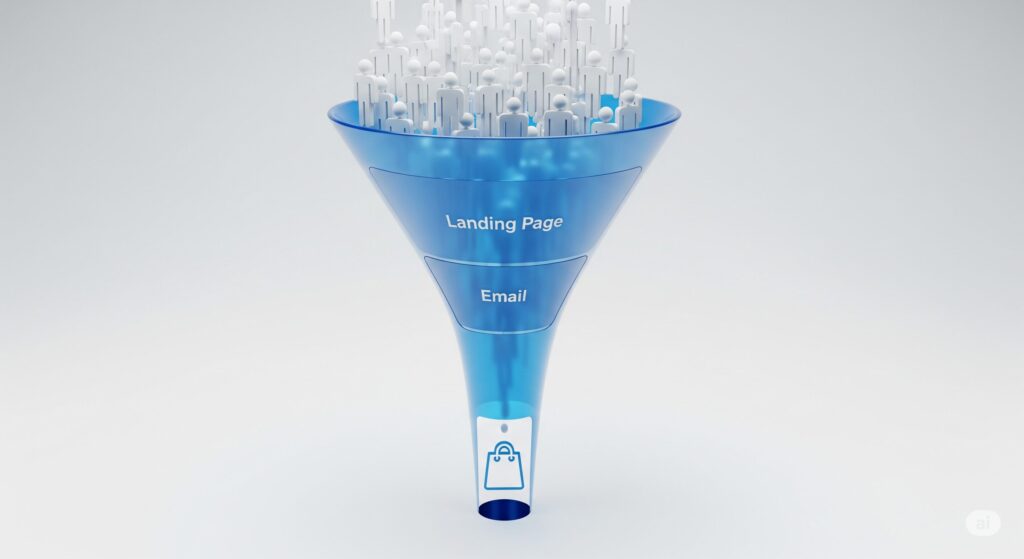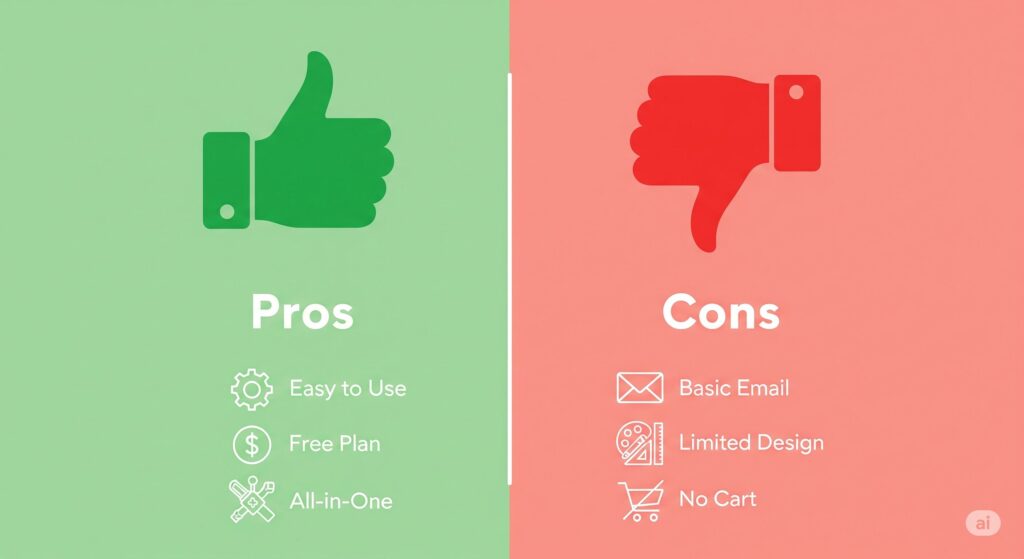Hey guys, hope you’re doing well. In this article, I’m going to share Systeme.io Tutorial of an all-in-one online business platform and whether it lives up to all the promises, features, and benefits stated on its website and its Trustpilot score of 4.8 stars.

With that said, let’s get on with this Tutorial.
What Exactly is Systeme.io?
To start off, what is Systeme.io? Based on my usage over the past week, the best way to describe it is as an all-in-one system to sell your products, especially when it comes to digital products.
On their website, you’ll see a full suite of tools they offer. You can:
- Create Sales Funnels
- Build your email list with built-in Email Marketing
- Build a website
- Integrate your own affiliate program
- Set up Business Automation and Evergreen Webinars
- Host Online Courses
- Start a Blog
- Sell your products directly
Personally, I’m often skeptical of all-in-one platforms. It’s hard to be great at every single feature, and the old saying “a jack of all trades is a master of none” often comes to mind. I approached this review from that skeptical perspective, keeping a mental note as I explored the entire system.
The biggest advantage I see with these all-in-one systems is exactly that—it’s all-in-one. You don’t need a multitude of different tools and subscriptions that add up in costs, like separate email marketing, a website and web hosting, a landing page builder, and a course hosting website. Another advantage is that all the different tools integrate with one another without any conflict.
The general disadvantage, as stated, is that these platforms may not be a master of any one aspect. Another rare downfall is that because you are hosting everything on one platform, you are putting all your eggs in one basket. But those are general things to know before considering signing up for any all-in-one platform.
Read Also
Systeme.io Review 2025: The All-In-One Tool That Finally Calmed My BrainSysteme.io’s Biggest Standout: The Free Plan
The biggest standout of Systeme.io is that they offer a free-forever plan that includes their entire suite of tools.

On their pricing page, you can see everything you get with the free plan:
- Contacts: Up to 2,000 contacts.
- Emails: Send an unlimited number of emails.
- Sales Funnels: Create up to 3 sales funnels with up to 10 steps each.
- Blog: Create one blog, which is more than enough if you’re just getting started.
- Course: Host one online course with unlimited students. (Note: students are different from email contacts).
- File Storage: You get unlimited file storage, so they don’t charge you based on how many videos you host for your course.
- Other Features: You also get access to automations, workflows, tags, email campaigns, order bumps, A/B split testing, and much more.
As you can see, you get the entire suite of products. The main difference between the plans is the amount of things you can create.
For perspective, an email list of 5,000 contacts on Systeme.io’s “Startup” plan costs only $17per month. With a popular platform like ActiveCampaign, 5,000 contacts would cost you $99 per month on their Lite plan. Signing up is simple. You can use my affiliate link in the description or go directly to systeme.io. Just enter your email, click the confirmation link, and create your password.
Click here to start with a free plan or get 40% off a paid plan.A Guided Tour of the Systeme.io Platform
Let’s get into the nitty-gritty and check out the actual dashboard and tools.
The Dashboard
The dashboard is simple, clean, and quite minimal. It shows your new leads and sales, and you can set a custom date range to see the stats you want. You can also toggle between your Main Dashboard and your Affiliate Dashboard (for when you are promoting other people’s products from the Systeme.io marketplace).
The marketplace itself seems quite new and only had 45 info products listed when I checked.
Contacts and Subscribers
This is the primary location for managing your subscribers. You can view all your contacts, filter them by details like name or email, and add new contacts one by one or import them from an existing email list.
When you click on an individual contact, you can see all their details, modify their tags, and even see how they subscribed (the source URL and squeeze page). Creating new tags is as simple as going to “Tags” and clicking “Add a new tag.”
Email Marketing
While on the subject of subscribers, let’s head to the email marketing platform.
- Newsletters: These are for sending one-off broadcast emails. This is what you’d use for a marketing promotion going out tonight. Creating one is straightforward: enter a subject line, choose between a Visual or Classic (plain text) editor, and write your email. The editor is a “what you see is what you get” (WYSIWYG) type, so you can click and modify anything directly.
- Campaigns: This is where you create an email series or sequence. For example, Day 1 sends Lesson 1, Day 2 sends Lesson 2, and so on. Setting this up was very easy. You add an email, write it, and then set the delay (e.g., 1 day after the previous email). You can also specify the time of day and days of the week for emails to be sent.
One thing I noted was a potential user experience issue. After saving changes in the email editor, nothing happens. You have to know to click “Exit” to proceed to the next step of scheduling and segmentation.
Another downfall I noticed was the basic email segmentation. You can include or exclude tags, but you can’t create advanced segments like “people who clicked a specific link in the last 6 months.” You can sort of get around this with automations, but it would be nice to have advanced filtering right in the email sending options.
Sales Funnels
Now for one of the fun parts: building sales pages, landing pages, and opt-in pages. It’s really easy to create a full-fledged sales funnel in a single day.

You can start by creating a funnel to build an audience, sell a product, or build a custom one from scratch. When you choose an option like “Sell,” it automatically creates the necessary Order Form and Thank You page steps. You then select from a variety of templates for each page.
One feature I wish Systeme.io had is a visual, flowchart-style representation of the sales funnel. Currently, you only see a linear list of your funnel steps (e.g., Squeeze Page -> Sales Page -> Order Form -> Upsell -> Downsell -> Thank You Page).
The page builder itself is intuitive. You can drag and drop elements like headlines, forms, and buttons. To connect an opt-in form, you simply click the button on the page and set the “Action when button clicked” to “Send form” and redirect to the “Next step URL.” This is great because you don’t need to copy and paste any shortcodes or HTML.
One downside I found is the lack of page history or revisions. You can undo recent changes, but you can’t revert back to a version of the page you saved last week. Another thing to be careful about: after making changes to funnel settings like pricing plans or resources, you must manually click the main “Save sales funnel step” button at the top right. It does not auto-save, which could cause you to lose work.
Finally, I noticed a lack of brand consistency in the templates. A sales page template may not have a matching thank you page or upsell page template. This means you’ll likely need to do some manual design work to make all your funnel pages look coherent.
Blogs
With the free account, you can create one full blog site, which is more than enough to start. You simply choose a name, set your URL, and pick a template. Once created, you can delete the dummy posts and start adding your own articles, pages (like About and Contact), and categories.
For SEO, you can go into each blog post’s settings to set your meta title, description, keywords, and social media image, which gives you a good chance of ranking in search engines. A small caveat with the free plan is that your blog will display a “Powered by systeme.io” badge in the footer.
Online Courses
If you’re selling a course, you can set it all up within Systeme.io. You create a course, add modules, and then add lectures (lessons) within each module. The course player for students is clean and simple. They can see all the modules, go through lessons, and mark them as complete.
In terms of customization, you can’t modify the layout of the membership portal much, but you can change the theme colors and main font to match your brand. You can also manage your students, see their progress, and enroll or revoke access to courses.
Automations
For more advanced functionality, Systeme.io offers Rules and Workflows.
- Rules are simple “if this, then that” automations. For example: IF a “new tag is added,” THEN “subscribe to an email campaign.”
- Workflows allow for much more complex automations with multiple steps and decisions. For example, you could create a workflow where if someone clicks a link in a specific email, they get a “Podcasting” tag. One day later, they receive an email with podcasting resources. Seven days after that, the system checks if they clicked a link in that email. If yes, send a course recommendation; if no, remove the tag. This level of automation is powerful.
Selling on Systeme.io: Products & Affiliates
I would say that Systeme.io isn’t the best for selling physical products. It lacks a traditional e-commerce storefront feature like Shopify, where customers can add multiple items to a cart and check out once. It’s primarily designed for direct-response offers of a single product.
For digital product sellers, however, it’s excellent. You can manage orders, transactions, and subscriptions. You can also create coupons for promotions.
Furthermore, you can set up your own affiliate program right inside Systeme.io, allowing other affiliates to promote your courses and products for a commission.
Advanced Settings & Integrations
In your account settings, you can set up payment gateways (Stripe or PayPal), customize mailing settings (like sender name), and most importantly, add a custom domain name so you can use your own www.yourdomain.com.
One of the best things is that Systeme.io integrates with Zapier, which opens up a whole new world of connecting to thousands of other apps like Shopify, Slack, or Airtable. This is a feature I always look for in a platform because it makes a business so much more streamlined.
The Big Verdict: Systeme.io Pros and Cons
So, should you sign up for Systeme.io? There’s no one-size-fits-all answer. Here is my breakdown of the pros and cons.

Cons
- Basic Email Segmentation: The filtering options for sending email broadcasts are quite basic compared to dedicated email marketing platforms.
- Limited Customization: Because it’s an all-in-one hosted system, you can’t modify things as flexibly as you could with WordPress. You are largely stuck with the provided templates and layouts, especially for the course portal and transactional emails.
- Not Ideal for E-commerce: The lack of a “shopping cart” feature makes it unsuitable for businesses selling multiple physical products.
- Inconsistent Template Design: Funnel page templates (opt-in, sales page, thank you page) don’t always have matching designs, requiring manual adjustments for brand consistency.
Pros
- Incredible Ease of Use: The platform is intuitive and much simpler than I expected. I was not overwhelmed when I logged in, and you can realistically create a full funnel in a single day.
- Amazing Free Plan: This is a huge advantage for beginners. You can build up to 2,000 contacts and have unlimited students for your course, all for free. One blog and one course are more than enough to get started and making money.
- All-in-One Simplicity: Everything is hosted for you. You don’t have to worry about updating plugins and themes, which saves time and reduces the risk of your site being hacked.
- Cost-Effective: The paid plans are extremely affordable. Once you’re making sales from your free plan, the $17/month “Startup” plan is an easy and valuable upgrade.
Frequently Asked Questions (FAQ)
1. Is Systeme.io actually free?
Yes. Systeme.io has a “Free Forever” plan that is very generous. It allows you to have up to 2,000 email contacts, build three sales funnels, host one course with unlimited students, and create a blog without ever needing a credit card.
2. Can I sell physical products on Systeme.io?
While you can sell physical products, the platform is not ideal for it. It lacks a traditional shopping cart feature where customers can add multiple items before checking out. It’s primarily designed and optimized for selling digital products and services.
3. Do I need my own website to use Systeme.io?
No. Systeme.io is an all-in-one platform and includes a website and blog builder. You can build your entire online presence directly on Systeme.io without needing a separate service like WordPress.
4. Can I move to Systeme.io from another platform like Mailchimp or WordPress?
Yes. You can easily import your existing email contacts from another service. For your blog, you would need to manually copy and paste your articles into the Systeme.io blog builder.
5. What are the main limitations of Systeme.io?
The main limitations are that its email segmentation is more basic than dedicated email platforms, the design customization for course pages is limited, and it’s not well-suited for e-commerce stores with multiple physical products.
Conclusion: Who Should Use Systeme.io?
Systeme.io isn’t the right platform for everyone, but I would say it is a great option if you are a digital product seller, an info-product creator, or someone who primarily sells virtual goods.
If you’re still hesitant, I would suggest you simply sign up for a free account. There’s nothing to lose. Play around with the tools, set up a test page, and create a dummy course. You don’t need to sell anything right away. It’s the best way to get a feel for what Systeme.io is all about.
I hope this was helpful and insightful. If you have any further questions, feel free to leave them in the comments!
READ MORE ARTICLES
How I Built a Tools Website with Google Gemini (A Step-by-Step Case Study)
The Ultimate Guide to Replacing Adobe Photoshop & Illustrator with Free Alternatives (2025)
Midjourney vs. Stable Diffusion: Which AI Art Generator is Right for You? (2025 Guide)
Huion vs. XP-Pen: The Best Budget Drawing Tablet for Beginners (2025)
